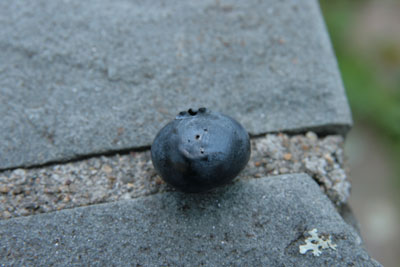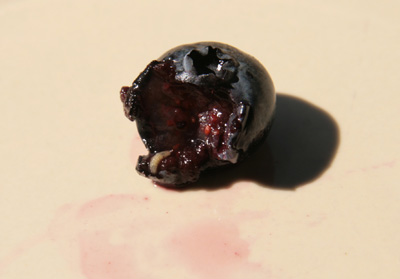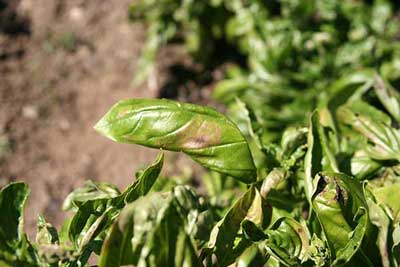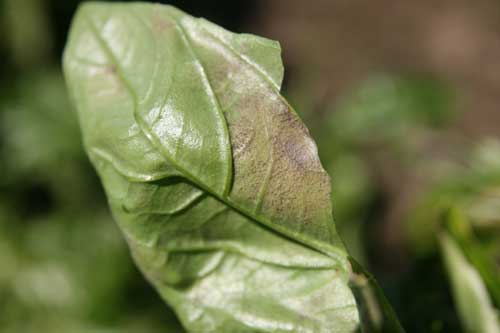Pest Report – August 29, 2013
Compiled by Eric Sideman, PhD, MOFGA’s Organic Crop Specialist
We have moved past the problems associated with the very wet summer that many of us experienced. In fact, many growers are now complaining about the lack of rain. Now the typical late summer problems are popping up, and some new pest and disease problems are too. Although some very suspicious pictures came in today, there have been no other reports late blight in Maine or New Hampshire, other than the report from the mid coast a few weeks ago and regular reports up in the County. Lots of people have sent me pictures of leaf hopper damage (Pest Report June 6, 2013), or Botrytis on tomatoes (May 29, 2013 Pest Report), or early blight (June 12, 2013 Pest Report) thinking it is late blight. Please continue to send pictures of anything suspicious so I can clear your mind, or tell you to worry. Late blight symptoms include brown to black lesions on the leaves, with little or no yellowing. It usually spreads quickly. Often you also see brown lesions on the fruit. We are lucky up here in northern New England. There have been many reports further south and in New York.
In this issue:
Spotted Wing Drosophila Update
Basil Downy Mildew
Plectosporium on Summer Squash
When to Harvest Winter Squash
 |
 |
 |
| Wound in a blueberry, caused by Spotted Wing Drosophila (SWD). | Berry softened by maggot of SWD. | SWD maggot revealed. |
SPOTTED WING DROSOPHILA (see the July 11 issue of the Pest Report for details)
Here on our farm the SWD is now in big numbers, as expected. Blueberries that we picked in July and most of August were mostly fine. Maybe we found a SWD infected fruit here or there. But now in late August it suddenly jumped to more than half of the fruit infected. The first sign is the fruit have a little hole or two in the side. That is where the fly laid an egg. I set some of those fruit aside on the counter and watched. The firm little berry with the hole got soft in about 3 days, and when cut open there was a maggot inside. If I had refrigerated it when I first picked it, the egg would have taken much longer to hatch and I could have eaten that fruit unaware.
 |
| Basil downy mildew |
 |
| Basil downy mildew spore production |
This is a pretty new problem, and it is all of a sudden widespread. We have lost all of our basil here on our farm, and the two farms I visited yesterday were quickly losing theirs. Downy mildew of basil was first reported in Uganda back in 1930. Recently it has been getting lots of attention as it spreads, first to Italy in 2004, France in 2005, United States (Florida) in 2007 and by 2009 New England. This year it is all over Maine and New Hampshire and we all have a chance to see it.
The first symptom is a pale yellowing of the upper surface of the leaves, quite similar to sunscald. Later, vein-bounded patches of dark spore production can be seen on the lower surface. This develops into a gray, fuzzy growth typical of downy mildews of other crops. At first you may be able to convince yourself that some soil has been splashed onto the underside of the leaf, but soon the plants will be going down and it will be clear that it is not a problem that can be washed away.
I bet that a lot more about this disease will be known next year than now. At this time we know that the disease may be seed borne, but that is probably a very rare event. The spread in most likely due to the wind blown spores. In the damp conditions of the early and mid summer they could move far and wide. There is also some belief that seedlings already infected and moved across country for sale play a role.
The infected leaves are safe to eat, and I have a report from a grower that mildly infected leaves still made a fine tasting pesto. Some types of basil are less or not susceptible at all. For example, my Thai basil is fine. I have heard from a grower that the lemon basil is not susceptible, and that the purple basil seems a bit less susceptible. The common sweet basil is the most susceptible. If you have this problem, and you grow more than one type of basil, please keep records and let me know if you see any resistance so we can make some recommendations for next year.
There are relatively few fungicides labeled for herbs. Also, I have not seen reports of efficacy of any. Some copper fungicides are labeled. Other OMRI listed products that are labeled for herbs include Actinovate AG, Trilogy, and OxiDate. But, again, I do not have any evidence that they are effective. If you try any of these, leave some plants untreated so we can get some information.
For now, anything that will make the leaves dry quickly will help, e.g., weed control, good spacing, venting tunnels, watering in the morning instead of the evening, etc.
 |
| Plectosporium blight on pumpkins |
 |
| Plectosporium stem lesions |
 |
| Plectosporium on zucchini fruit |
PLECTOSPORIUM BLIGHT [ON ZUCCHINI] (modified from a report by T. Jude Boucher, University of Connecticut, Cooperative Extension System)
Plectosporium blight, caused by the fungus Plectosporium tabacinum (formerly known as Microdochium tabacinum), is a relatively new destructive disease of cucurbits in New England. This disease was found in Tennessee in 1988 and has since spread rapidly throughout the eastern United States. It occurred on a single farm in Massachusetts in 2000 and on at least a dozen farms in Connecticut and Massachusetts in 2003. In the fall of 2004, after two seasons of rainy weather, it was present in every field Jude visited from Long Island Sound to Burlington, Vermont. I saw a lot of it in Maine in 2006, and I am now seeing it again this wet season, especially on zucchini.
Plectosporium blight is known to cause damage to a wide variety of cucurbit crops in Europe and Asia, but the strain present in the U.S. seems to primarily damage pumpkins, summer squash, zucchini and a few varieties of gourds. In wet years, which favor disease development and spread, crop losses in no-spray and low-spray fields can range from 50 to 100%.
This disease is easily recognized but is difficult for organic growers to manage. If you spot it, be prepared to implement good sanitation and develop an effective crop rotation of your cucurbits to clean fields next season.
Description and Management:
The clearest symptom to look for on vines and petioles are white lesions that tend to be diamond to lens-shaped; and on fruit and leaves the lesions are usually round and white.
Plectosporium blight is favored by cool, rainy weather. The fungus can overwinter on crop residue and thus can persist in the soil for several years. Plectosporium has not been reported to be seed-borne. Tiny, one or two-celled, sickle-shaped spores are formed in lesions on vines, stems, fruit, leaves and leaf petioles. Spores are dispersed by wind over long distances. Lesions are small (<1/4 inch) and white. The lesions increase in number and coalesce until most of the vines and leaf petioles turn white and the foliage dies. Severely infected pumpkin vines become brittle and will shatter if stepped on. Early in the infection cycle, foliage tends to collapse in a circular pattern before damage becomes more universal throughout the field. These circular patterns can be easily detected when viewing an infected field from a distance. Numerous fruit lesions produce a white russeting on the surface and stems that render the fruit unmarketable. Fruit lesions also allow for entry of soft rot pathogens that hasten the destruction of the crop.
Disease management recommendations include:
- a 2-3 year crop rotation
- planting in sites with good air circulation to encourage rapid drying of the foliage
- switching to trickle irrigation if you have been using overhead
- scouting fields to confirm the presence of Plectosporium, and plowing under crop residue after harvest
- Although there are some fungicides for conventional growers, the fungicides available to organic growers are not thought to offer adequate control.
WINTER SQUASH LOOKS READY – SHOULD I HARVEST?
Winter squash look ready to harvest before they actually are mature. It is important to wait for maturity to have maximum storage and best eating quality. Most squash varieties reach full size by 20 days after fruit set. Accumulation of starch and other dry matter peaks at about 30-35 days after fruit set. But, the fruit is not fully mature until the seeds are fully developed, which occurs about 55 days for butternut. This is different for other varieties. If you would like to read more, take a look at this article by Brent Loy, the very well known plant breeder at the University of New Hampshire:
Maximizing Yield and Eating Quality in Winter Squash – A Grower’s Paradox
Or, here is a summary put together by the folks at Johnny’s Selected Seeds:
Eating Quality in Winter Squash & Edible Pumpkins
 |
| Winter squash curing in a greenhouse |
Harvest and Storage
Another critical factor in eating quality is maturity of the squash when it is harvested. Most small varieties reach full size by 20 days after fruit set. Accumulation of dry matter and starch content peaks at 30 to 35 days after pollination. However, the fruit is not mature until the seeds are fully developed, which occurs about 55 days after fruit set.
Dr. Loy stresses the importance of maintaining healthy plants until at least 50 days after fruit set because photosynthesis is essential to the development of sugars and dry matter. A squash that is picked too early will continue to develop seeds, but it does so by depleting the dry matter, thereby reducing eating quality.
Although fruit and seed maturity are similar across the three main species of edible winter squashes and pumpkins, harvest and storage recommendations vary by type.
Cucurbita maxima | Kabocha, Hubbard, and Buttercup Squashes
Kabocha, hubbard, and buttercup (C. maxima) varieties should be harvested before complete seed maturation, at about 40 to 45 days after fruit set, when the fruit is still bright green. That’s when the rind is hardest, so less likely to be damaged in storage. They also are susceptible to sunburn as the vines die down, so it’s best to get them harvested and out of direct sun before then to prevent the rind from turning brown or, with extreme sunburn, white. Kabocha squash have a high dry matter content and small seed cavity, so seed maturation off the vine is not a problem. However, once harvested, they should be stored at room temperature for 10 to 20 days to allow sugars to reach acceptable levels.
C. pepo | Acorn Squash, most Pie Pumpkins
Acorn squash (C. pepo) are misleading because they reach full size and develop a dark green-to-black mature color about two weeks after fruit set – 40 to 50 days before they should be harvested. Dr. Loy says that a better way to judge maturity is to look at the rind where it touches the ground. Immature squash have a light green or light yellow ground color, whereas mature squash have a dark orange ground color. Immature acorn squash have low sugar levels and although they will develop sweetness after harvest, they do so by depleting the dry starchy matter to convert it to sugars. This means storage life is shortened and eating quality declines.
C. moschata | Butternut Squash, some Pie Pumpkins
Butternut squash (C. moschata) are easier to judge by sight because they don’t acquire their characteristic tan color until late in development, 35 days or more after fruit set. If the weather stays frost-free, they should be allowed to remain on the plants until 55 days after fruit set. In short-season areas, they often are harvested soon after turning tan because of the risk of frost damage. At that point, however, the sugars have not elevated to the 11% required for good flavor, so butternut squash harvested at 55 days after fruit set should be stored for 60 days at 56-60°F/10-16°C, with relative humidity between 50 and 70%. Carotenoid content also increases in storage, making the butternut squash more nutritious after it’s been stored for a couple of months. To accelerate maturity and increase sweetness, Dr. Loy has found that butternuts held at warm temperatures (up to 85°F/29°C) for two weeks develop acceptable levels of sugars.

